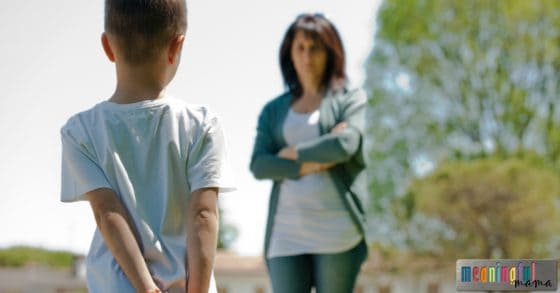Are physical consequences ever appropriate? Oh no she didn’t! She’s hitting on a hot button issue today. I might be crazy for broaching such a controversial topic, but I’m going to share my current thoughts and experiences on the topic. I’ve talked about consequences for kids before, and it seems to be a question that parents continue to struggle with. What consequences are appropriate and effective? I hear you! I struggle with it too. That said, I always want to share what I’m doing and learning as I parent these kiddos that I love dearly.
I continue to wrestle with this topic. Let’s make it clear, up front, that what is right for one family might not work for another. In no way am I saying all parents need to share and implement my take on the conversation. If you disagree with me, I understand. What I do ask is that all comments be delivered in a way that show respect so that your voice and concern with the matter can be heard. I also encourage you to read the entire article before passing judgment so consider things critically.
Spanking will not be addressed today. I have intentionally avoided that topic on my blog, and I will do so today. If you are a family that has chosen to spank (or even if you are curious or up in the air on the topic), I encourage you to listen to this podcast by my dear friends David & Kelli at Axis Ministries addressing the topic of spanking.
Are Physical Consequences Ever Appropriate?
“Are physical consequences ever appropriate?” Yes. I believe so. That’s the short answer, but there’s more to come so stick with me.
I want to set some groundwork. I believe a number of parenting strategies can be implemented very effectively or very poorly.
Let’s take schooling choices for example: homeschool vs. public vs. private. I believe parents can do each of these schooling choices very well or horribly wrong. I have seen amazing children produced out of all three of these environments.
In the same way, I have parents I respect that would never use physical consequences and their kids aren’t deviants. They are super kids. I also know parents who use physical consequences as a strategy and their children are amazing. A physical consequence can be done in an awful way or can be implemented in such a way that can have a positive impact on a child – both their heart and their behavior.
When studies come out about how certain consequences negatively impact children, I always feel like the flaw in the study is the varying degree in which the consequence was issued. We never know whether a consequence, either physical or not, is executed in anger or in a calm, controlled and loving way. The way a consequence is administered has a huge impact on it’s effectiveness.
Some are concerned that the use of physical work or exercise will negatively impact their ability to “like” these those things. My experience is different when the strategy is done well. I talk to many who grew up with these kind of consequences, and they are some of the most hard working and disciplined people I know.
Ideas to Keep in Mind When Giving Consequences
- Consequences should be used as teaching moments. Try and give your kids consequences that make sense to tie in the behavior with the outcome. You can get creative on what a punishment or reward might look like for a given situation and how you can tie in a physical consequence with a lesson to be learned about behavior. For example, if your child has been mistreating their sibling and you want them to run you can say, “You’ve been running over your brother with the way you are treating him, so now it’s time for you to do a different kind of running around.”
- Get to their heart. It is great to explain your consequence with an emphasis on love. “We love you so much that we can’t allow you to act like that. Imagine if you showed this kind of disrespect to your boss or teacher. It just won’t benefit you in life, so we have to teach you another way so you can thrive and we successful.” I love to tie things back to scripture and what God wants from us – not out of obligation but out of a thankfulness for the love and mercy he has shown us. Further, trusting God in His best for us. Avoid legalism and fire and brimstone when doing this. You can also get to their heart by appealing to empathy. “How would you feel if you were holding something and someone else came and snatched it out of your hands?
- Give them opportunities to do it right. Use this clutch phrase for one opportunity to respond the right way in certain situations.
- Re-enact the gospel. We want our home lives to reflect the gospel message. We screw up. We sometimes reap consequences for our behavior. We apologize and accept amazing grace. Hopefully, we change our ways. Teach your kids to say “I’m sorry.” Make sure they know they are forgiven completely (it might still mean there are lingering consequences for their actions). Love on them. Another add on here is teaching a child to say to you or anyone else they have wronged, “How can I make it right?”
- Be consistent.
- Read this post to remember the importance of teaching obedience and the proven best kind of parenting style.
- Do not discipline in anger. We often enter into harsh, rash and hurtful consequences when we are angry. It is OK to say, “Mom needs to cool off, think this through and come back to give a consequence when I can do so appropriately and in love.”
- Praise your child. Make sure the words your child hears are not all re-direction, disappointment and discipline. Find opportunities, often, to tell your child how much they are adored. Talk about what you admire about them. Build into them the security of your love. Compliment them whenever possible.
- Teach before the moment. It is important to not just teach your children in the moment of discipline. Find fun games like this one for teaching obedience. Check out my character development series to teach the character you want in engaging way. Follow this tip to secretly teach the behavior you want.
Some of the Physical Consequences I Give
- Chores – Read more about that here.
- Doing a one minute plank. This is my favorite for disrespect.
- Moving appropriate sized rocks out of the garden.
- Running around the house.
- 20 push ups
- 20 squats
- Sitting in one place for a controlled amount of time. Learn more about teaching kids to sit still here.
- Doing a wall squat for an appropriate amount of time depending on their size and strength.
*Note: None of this is physical abuse.
The Benefits of Physical Consequences
What are some of the benefits to physical consequences?
- Learning Self Control – It takes a lot of physical control to do certain exercise. The wall sit, for example, is a great way to focus on control. A child is learning to control their body. It should be relayed to the child that self control is the intended goal.
- Focus – It takes focus to accomplish a task. This focus can shift from their negative behavior to something positive they are accomplishing.
- It Develops Strength – Strength of both character and physical strength begins to emerge.
- It Diverts Energy – Kids can have excess energy that leads to inappropriate behaviors. To let kids get this energy out in the consequence helps their body get what it was craving in the first place.
- Physical Pressure Can be Calming – I have one child, in particular, who has a body that craves pressure. We have a weighted blanket for that child. Having someone lay on her is a healing time. When we have this child plank, the pressure that is put on her body completely grounds her. She becomes re-directed after the consequence is issued. You watch her countenance transform in a positive way.
- It Teaches Hard Work – I believe we live in a society where kids are being babied too much. Generations ago, kids learned hard work. They worked in the house and in the farm. We feel that making our child endure hard work will somehow harm them, when in fact it is teaching them that life has work involved. It also shows that consequences, both positive and negative, are a part of our behavior choices. Sometimes our work does become harder when we are behaving poorly. That is a perfect conversation tie in to the consequence. “Life gets harder when we make bad choices.”
What to Keep in Mind When Giving Physical Consequences
- Do nothing that would cause physical harm. Asking an overweight child to do push-ups can adversely effect their health. Another physical consequence appropriate to that child’s ability might be better. Keep hydration levels up. There should be nothing that would cause injury like lifting things that are too heavy for their body or doing lifting for a prolonged amount of time. Do not be cruel in your parenting. Do nothing to humiliate.
- Do not be extensive. Asking your child to run around the house 4 times is a lot different than pushing them beyond their physical limits. If your child talked back to you, it would be extensive to give them hours of physical labor. Keep this in check. If you over-do it you could create an adverse response to work and exercise in the future.
- Try and tie in the consequence with the behavior. This isn’t always possible, and I think it’s OK to have some that don’t link. However, if it’s completely disconnected there is no learning opportunity.
- Parent child by child. Not every child will respond well to physical consequences. What works for one will not work for another. Be adaptable rather than firm on your chosen methods. For some kids, this will be extremely effective and for others it could be damaging. Know your children well! Be aware if some have asthma problems, joint problems or a weak body that should not be pushed physically for the sake of their health.
- Teach afterward. “You got a consequence for hitting your brother. What can you do next time when you are frustrated?” Don’t just give a consequence and let it be. Help them brainstorm and learn an alternative to their choices.
- This is only one strategy. I would not use physical consequences as your end all be all method for raising your children. When used appropriately, I believe it can be effective. That said, if you want to rely on it as your primary method, I would consider other options to create a more comprehensive and creative approach to parenting.
- This strategy is for use in a loving home. I am not promoting this strategy for teachers or coaches. Further, I would give serious consideration to these strategies if your child was adopted, especially at an older age. You do not know what they may have been meant to endure in their past environment.
- Be Age Appropriate. I did not do this when my children were young. I believe about 7 or 8 is a good time to try some of these methods. That’s just personal experience talking though.
I know this is a controversial topic. Carefully consider what is right for your family.
To anyone who has been harmed in the process or physical parenting, I am so incredibly sorry that this was not modeled or done well.
Do all things with grace and love. I do believe some parents haven’t considered that there can be benefits to appropriate physical consequences. I believe physical consequences can be an effective tool of parenting for some children when done with care. Parent on, Friends!







